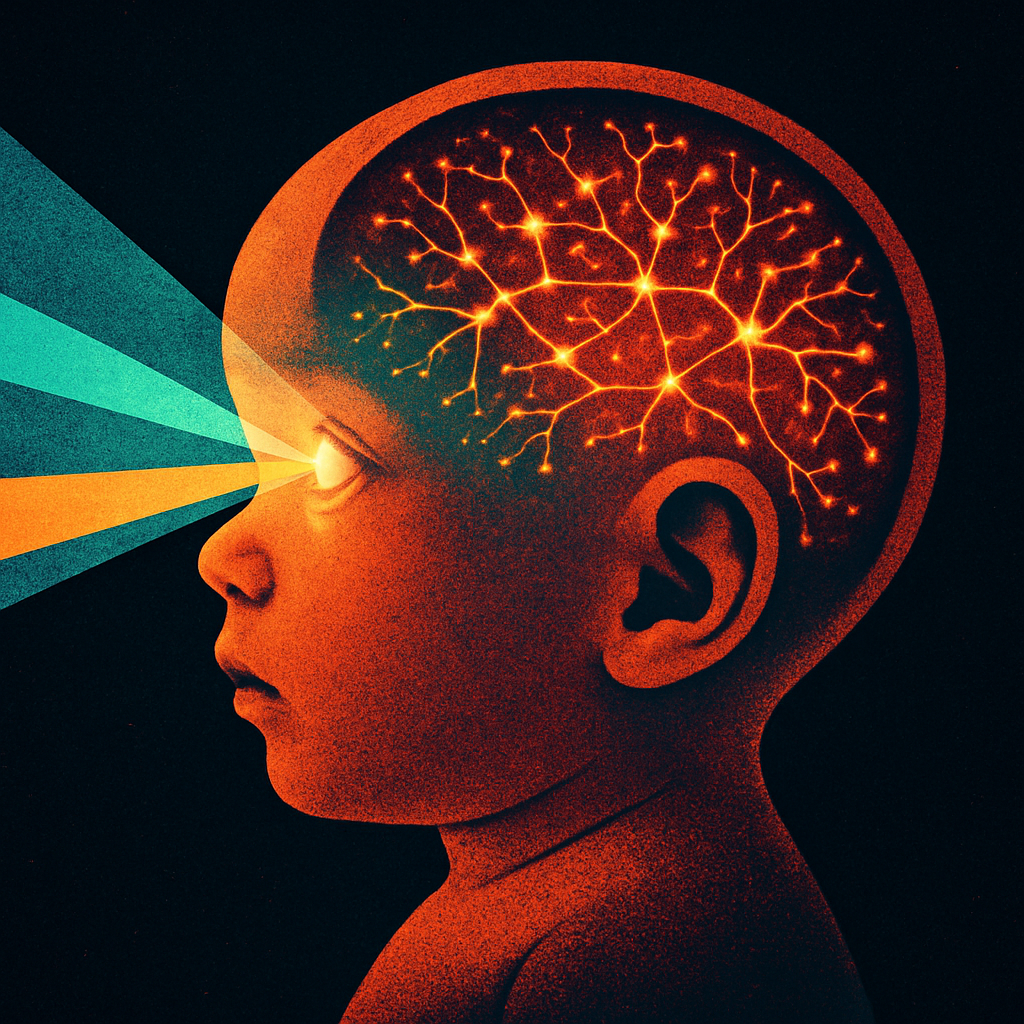Did you know that vision and hearing are vital to your baby’s brain development? Studies suggest that up to 50-60% of the brain is involved in processing visual information, making sight a powerhouse for growth. Meanwhile, hearing tunes into language even before birth, with fetuses processing sounds like their mother’s voice by the third trimester. As you cheer on milestones like rolling and crawling, sight and sound are silently wiring the neural circuits that drive these skills and future learning.
How do sight and sound build your baby’s brain architecture?
Sight and sound fuel rapid brain growth. Visual information activates the occipital cortex, which uses over half of the brain’s surface, while auditory input reaches hearing centers by 25 weeks of gestation. See Stanford Children’s Health on Hearing. These senses work together to build neural connections that support learning and movement.
When your baby sees your mouth move while hearing your sing-song “parentese,” mirror neurons connect sight and sound, speeding up language skills and social bonding. Sensory input also strengthens the inner ear’s vestibular system, which aids balance. Untreated hearing loss can nearly triple fall risk later in childhood.
Daily conversation, colorful mobiles, and gentle music don’t “spoil” your little one; they stimulate billions of new neural connections. Pair those sensory moments with movement—ideas inside How Physical Activity Boosts Your Baby’s Brain—and you create an unbeatable growth recipe.

Which hearing and vision milestones unfold in the first 24 months?
Milestones are a guide, not a strict rule. Every baby develops at their own pace, but the table below highlights key checkpoints to watch for, helping you know when to seek support.
| Age | Hearing Highlights | Vision Highlights |
|---|---|---|
| Birth | Startles at loud sounds; soothed by parent’s voice | Sees 8–10 in / 20–25 cm; loves high-contrast shapes |
| 2 months | Quiets to familiar voices; starts cooing | Shows a social smile; briefly follows faces |
| 4 months | Turns head toward sounds | Tracks a moving toy across midline |
| 6 months | Begins babbling (“ba-ba”) | Notices colors; reaches accurately |
| 9 months | Understands “no” and own name | Depth perception improves; picks up small objects |
| 12 months | Imitates simple words | Looks across room; points with purpose |
| 18 months | Says 10–20 words | Scribbles; stacks blocks |
| 24 months | Uses two-word phrases | Near-adult 20/20 vision |
Screening timeline
- Newborn hearing test (ABR or OAE) before hospital discharge.
- First comprehensive eye exam by 6 months.
- Sensory checks at every well-visit; formal hearing follow-up by 6 months if issues noted.
About 2–3 in 1,000 babies have significant hearing loss, and vision issues can affect learning. Early screening catches problems fast.
For detailed hearing milestones, check NIDCD’s Hearing Checklist. For vision milestones, see AAO’s Vision Development Guide.
On the other hand, about one in six children will face a vision problem that can hinder learning. Matching sensory and motor progress—see the charts in Gross Motor Milestones: Supporting Your Baby’s Brain—gives the clearest picture of overall development.
What can you do between screenings to keep sensory development on track?
Mindful play for a few minutes daily supports sensory growth. Try these activities:
- Clap or jingle keys out of sight to see if your baby turns toward the sound.
- Move a bold black-and-white card slowly to encourage gaze tracking.
- Narrate diaper changes, meals, and walks; varied words feed auditory pathways.
- Use tummy time with colorful, textured mats to connect vision, touch, and movement.
- Protect ears by keeping toys under 85 dB as per DecibelPro on Safe Noise and eyes with 100% UVA/UVB sunglasses outdoors according to Lighthouse Guild Eye Protection.
More Ways to Help:
- Pick toys with soft sounds or volume controls, like plush toys or infant-safe musical instruments (e.g., Fisher-Price rattles).
- Choose baby sunglasses from brands like BabyBanz or Little Tikes, which offer wraparound UV protection.
- Read bright picture books while gently rocking your baby to blend visual, auditory, and movement stimulation.
Worried about ear infections? Learn more in Ear Infections and Your Baby’s Brain to understand when fluid might muffle sounds.
Your top questions, answered
-
When should I worry if my baby isn’t babbling?
No consonant sounds by 7 months? Get a hearing check. Early testing can spot issues and start speech therapy if needed. -
Why does my 4-month-old still cross her eyes?
Occasional crossing is normal until 4–5 months. Constant crossing calls for an eye exam, as persistent strabismus can blur vision. -
Can loud toys hurt tiny ears?
Yes—sounds over 85 dB can harm delicate ear cells. Test toys by holding them to your ear; if too loud, skip or limit them. -
Do sunglasses really matter for babies?
Yes—UV rays increase risks of cataracts later. Choose wraparound sunglasses labeled 100% UVA/UVB for sunny outings. -
How can fine-motor play support sensory growth?
Small movements reinforce sensory learning. Simple tasks like grasping soft blocks or turning pages. See Fine Motor Skills: Boosting Your Baby’s Brain Power) integrate touch, sight, and sound for richer brain wiring.
How do strong senses today shape tomorrow’s learning?
Clear hearing and vision ignite the neural networks that power language, balance, emotion, and curiosity. By tracking milestones, scheduling screenings, and weaving sensory-rich moments into daily life, you give your child the clearest window—and soundtrack—through which to explore the world. Your mindful attention now lays the strongest foundation for a lifetime of confident learning and joyful discovery.